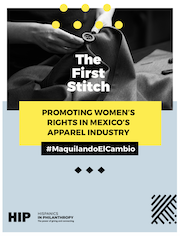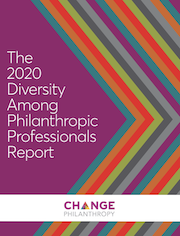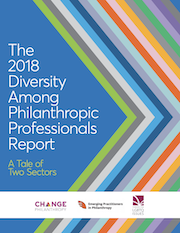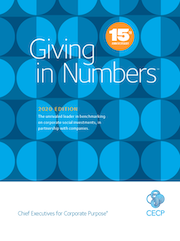Site Search
- resource provided by the Forum Network Knowledgebase.
Search Tip: Search with " " to find exact matches.

This report from Hispanics in Philanthropy, highlights both the circumstances that women face in the apparel industry and the broader economic environment in which apparel companies operate, which significantly affects how these companies treat their employees. It aims to provide philanthropies that focus on women’s well-being – especially those interested in guaranteeing equitable access to safe and fair work for women – with an innovative example of how they can direct their efforts: supporting projects that directly engage the private sector in examining the causes of injustice and human rights abuses and ultimately ameliorating them.

This second edition of the Diversity Among Philanthropic Professionals (DAPP) Report offers a snapshot of the philanthropic sector’s workforce in a very specific space and time — in the chaotic year that was 2020. The DAPP report aims to help the philanthropic community better understand its workforce and leadership. It is unique in soliciting anonymous self-reporting from individuals on the staff and board of participating foundations, helping grantmakers to accurately assess the culture and climate of their institutions.
CNJG invites members to attend this webinar to learn about the DAPP survey and report from CHANGE Philanthropy. This webinar is for United Philanthropy Forum members and its members’ members, meaning CNJG and its members are all eligible and invited to attend.
Now entering its 4th iteration, the Diversity Among Philanthropic Professionals (DAPP) Survey and Report aims to help the philanthropic community better understand its workforce and leadership. In addition to featuring one of the most comprehensive demographic sections in the sector, the DAPP has several features designed to help institutions better understand the experiences of distinct communities and provide real data to participants on the state of diversity, equity, and inclusion in their home institutions. In this exciting session, representatives from CHANGE Philanthropy will present an in-depth overview of the DAPP, with emphasis on its history, core features, and examples of how PSOs can apply the DAPP data to their own knowledge building efforts. Our hope is that this session helps attendees think about how to use the DAPP to make changes in their own institutions.
Learning Outcomes:
• Explore possible ways of utilizing DAPP data to effect change in support of greater inclusion.
• Understand the features of the DAPP report and how to participate in future surveys.
• Connect with CHANGE partners for further resources to support diverse teams.
Process Questions:
• What is the DAPP?
• What special incentives exist to encourage participation?
• How have others used the DAPP to address workplace culture?
• How can CHANGE partners help you in promoting inclusive workplaces?
Presenters:
Tenaja Jordan, Research & Communications Director at CHANGE Philanthropy
Deborah Aubert Thomas, CEO, Philanthropy Ohio, and Forum Racial Equity Committee Chair
COST: Free for CNJG Members
(You will need to create an account on United Philanthropy Forum’s website in order to register for the program).
As part of its ongoing commitment to students, the Educational Testing Service (ETS) awarded eight scholarships to students attending colleges across the nation.
The assessment and research organization, presented more than $80,000 in scholarships to students this year through two of its scholarship programs, ETS CARES Scholarship and the Trenton Central High Scholarship. The Trenton Central High scholarships are renewable up to four years, assuming the students maintain a 3.0 GPA.
"We are so proud to support you on this journey--your future matters to us," ETS President and CEO Amit Sevak told the students at an awards ceremony held in their honor on July 14. "These scholarships are part of our commitment to give back, especially here in our state of New Jersey. I also want to recognize the ETS staff because without their incredible generosity, these scholarships and our other work in the community would not be possible."
Low levels of diversity in the senior ranks of foundations have proven to be a stubborn challenge for the field of philanthropy. A newly-released report by Forward Change takes an important step toward a deeper understanding of the career pathways of professionals of color in philanthropy—how they enter foundations, how they advance across their careers, and what factors affect their advancement within the sector.

In the inaugural Diversity Among Philanthropic Professionals (DAPP) Survey, participants were asked to identify their role within their foundation, their age, gender identity, sexual orientation, race and ethnicity, and disability status. This report lays out the results of the DAPP survey in aggregate form.
Produced in partnership with CHANGE Philanthropy and Emerging Practitioners in Philanthropy (EPIP), the report and accompanying infographic explore diversity in the philanthropic workforce. Overall, the report finds a statistically significant difference between funders with a social justice focus and all other funders. Social justice funders were much more likely to have higher representation of LGBTQ people, people of color, and people with disabilities.

BD contacted the Corporate listserve to ask questions to benchmark Community Service/Volunteer Paid Time Off Policy & Internal Company Guidelines for Volunteer Councils. They are formalizing some of their programs and wanted to see what other companies are doing.
Community Service/Volunteer Paid Time Off Program – BD allows US employees 2 days off for personal volunteer time with several restrictions on organization types. We have guidelines but no formal policy. Currently we don’t track participation or hours. To help us, please answer the following questions:
Do you have a Community Service/Volunteer Paid Time Off Policy/Program? If so:
- How many paid days off per year are given to employees?
- Is your program limited to just US employees or are International employees included?
- Are there any limitations to the types of volunteer projects/organizations that are acceptable?
- Is the time off limited to company-sponsored projects or is it open to individual employee volunteer experiences?
- Is manager approval required and if so, how is this tracked?
- How do you track the volunteer hours?
- Does the policy fall under the responsibility to Human Resources or Corporate Social Responsibility?
- Would you be willing to share your policy please?
Company Employee Volunteer Councils – BD has groups of employees at most of our sites who organize volunteer projects for local employees to participate in. We call these groups Volunteer Councils. We do not have any written guidelines for the Volunteer Councils but feel this would be helpful especially in reporting outcomes to our Corporate Social Impact Team. To help us, please answer the following questions:
Do you have Volunteer Councils who coordinate and manage volunteer activities for your site locations? If so:
- Do you have guidelines on how these Volunteer Councils should operate?
- Are there any restrictions on the type of volunteer projects that associates can manage on behalf of the company?
- Do you provide any Corporate grant dollars for the Volunteer Councils to use to support their nonprofit partners?
- Would you be willing to share your guidelines please?
Responses came from 17 corporations from the CNJG community and other corporate giving programs from different areas of the country.

CECP’s Giving in Numbers™is the unrivaled leader in benchmarking on corporate social investments, in partnership with companies. It is the premier industry survey and research, providing standard-setting criteria in a go-to guide that has defined the field and advanced the movement. CECP has the largest and most historical data set on trends in the industry, shared by more than 585 multi-billion-dollar companies over nearly 19 years, representing more than $312 billion in corporate social investments over that time span. The report is embraced by professionals across all sectors globally to understand how corporations invest in society, with topics ranging from cash and in-kind/product, employee volunteerism and giving, and impact measurement.
